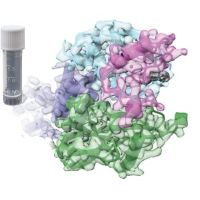Specification
| Description | Recombinant protein from the full-length sequence of Homo sapiens kelch domain containing 2 (KLHDC2) (NM_014315). |
| Organism | Homo sapiens (Human) |
| Expression Host | Human Cells |
| Tag Info | His or DYKDDDDK. Please contact us if you need further information or require specific designed tag. |
| Purity | Greater than 90% by SDS-PAGE gel |
| Uniprot ID | Q9Y2U9 |
| Entry Name | KLDC2_HUMAN |
| Gene Names | KLHDC2 HCA33 |
| Alternative Gene Names | HCA33 |
| Alternative Protein Names | Kelch domain-containing protein 2 (Hepatocellular carcinoma-associated antigen 33) (Host cell factor homolog LCP) (Host cell factor-like protein 1) (HCLP-1) |
| Application | Antigens, Western, ELISA and other in vitro binding or in vivo functional assays, and protein-protein interaction studies; For research & development use only! |
| Buffer | Purified protein formulated in a sterile solution of PBS buffer, pH7.2, without any preservatives |
| Endotoxin | Endotoxin level is < 0.1 ng/µg of protein (<1EU /µg) |
| Length | 406 |
| Molecular Weight(Da) | 46099 |
| Protein Sequence | (The sequence of expressed protein may have some variation from the sequence shown below. Please contact us for the exact sequence.) MADGNEDLRADDLPGPAFESYESMELACPAERSGHVAVSDGRHMFVWGGYKSNQVRGLYDFYLPREELWIYNMETGRWKKINTEGDVPPSMSGSCAVCVDRVLYLFGGHHSRGNTNKFYMLDSRSTDRVLQWERIDCQGIPPSSKDKLGVWVYKNKLIFFGGYGYLPEDKVLGTFEFDETSFWNSSHPRGWNDHVHILDTETFTWSQPITTGKAPSPRAAHACATVGNRGFVFGGRYRDARMNDLHYLNLDTWEWNELIPQGICPVGRSWHSLTPVSSDHLFLFGGFTTDKQPLSDAWTYCISKNEWIQFNHPYTEKPRLWHTACASDEGEVIVFGGCANNLLVHHRAAHSNEILIFSVQPKSLVRLSLEAVICFKEMLANSWNCLPKHLLHSVNQRFGSNNTSGS |
Background
| Function | FUNCTION: Substrate-recognition component of a Cul2-RING (CRL2) E3 ubiquitin-protein ligase complex of the DesCEND (destruction via C-end degrons) pathway, which recognizes a C-degron located at the extreme C terminus of target proteins, leading to their ubiquitination and degradation (PubMed:29779948, PubMed:29775578, PubMed:30526872). The C-degron recognized by the DesCEND pathway is usually a motif of less than ten residues and can be present in full-length proteins, truncated proteins or proteolytically cleaved forms (PubMed:29779948, PubMed:29775578, PubMed:30526872). The CRL2(KLHDC2) complex specifically recognizes proteins with a diglycine (Gly-Gly) at the C-terminus, leading to their ubiquitination and degradation (PubMed:29779948, PubMed:29775578, PubMed:30526872). The CRL2(KLHDC2) complex mediates ubiquitination and degradation of truncated SELENOK and SELENOS selenoproteins produced by failed UGA/Sec decoding, which end with a diglycine (PubMed:26138980, PubMed:30526872). The CRL2(KLHDC2) complex also recognizes proteolytically cleaved proteins ending with Gly-Gly, such as the N-terminal fragment of USP1, leading to their degradation (PubMed:29775578, PubMed:30526872). May also act as an indirect repressor of CREB3-mediated transcription by interfering with CREB3-DNA-binding (PubMed:11384994). {ECO:0000269|PubMed:11384994, ECO:0000269|PubMed:26138980, ECO:0000269|PubMed:29775578, ECO:0000269|PubMed:29779948, ECO:0000269|PubMed:30526872}. |
| Pathway | Protein modification; protein ubiquitination. |
| Protein Families | |
| Tissue Specificity | Widely expressed, with high levels in skeletal muscle, heart, pancreas and liver (PubMed:11384994, PubMed:16964437). Undetectable in peripheral blood leukocytes (PubMed:16964437). {ECO:0000269|PubMed:11384994, ECO:0000269|PubMed:16964437}. |
QC Data
| Note | Please contact us for QC Data |
| Product Image (Reference Only) |  |

